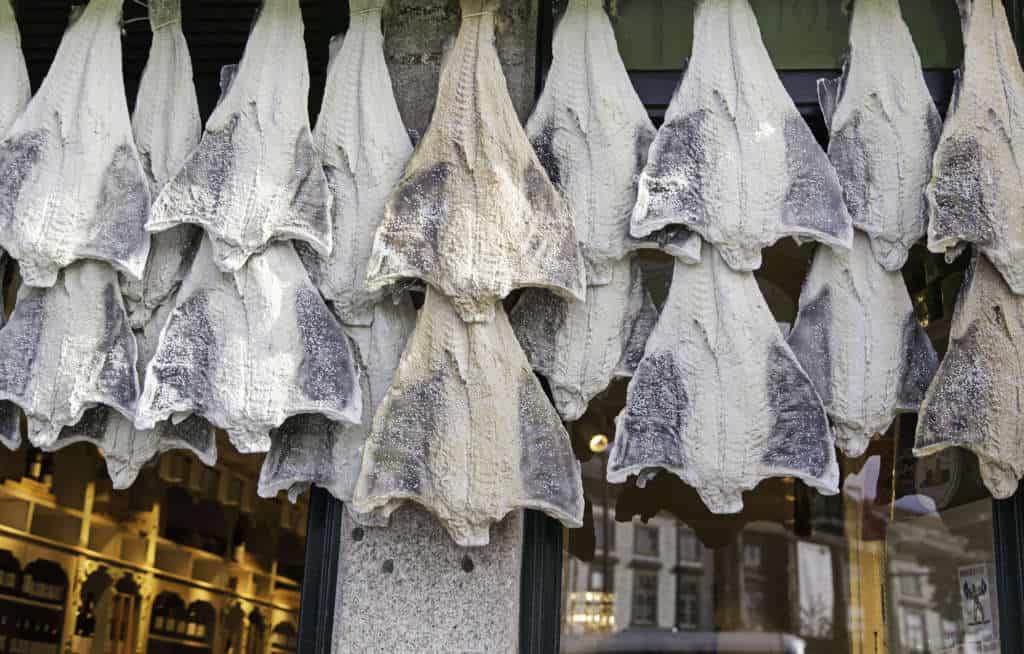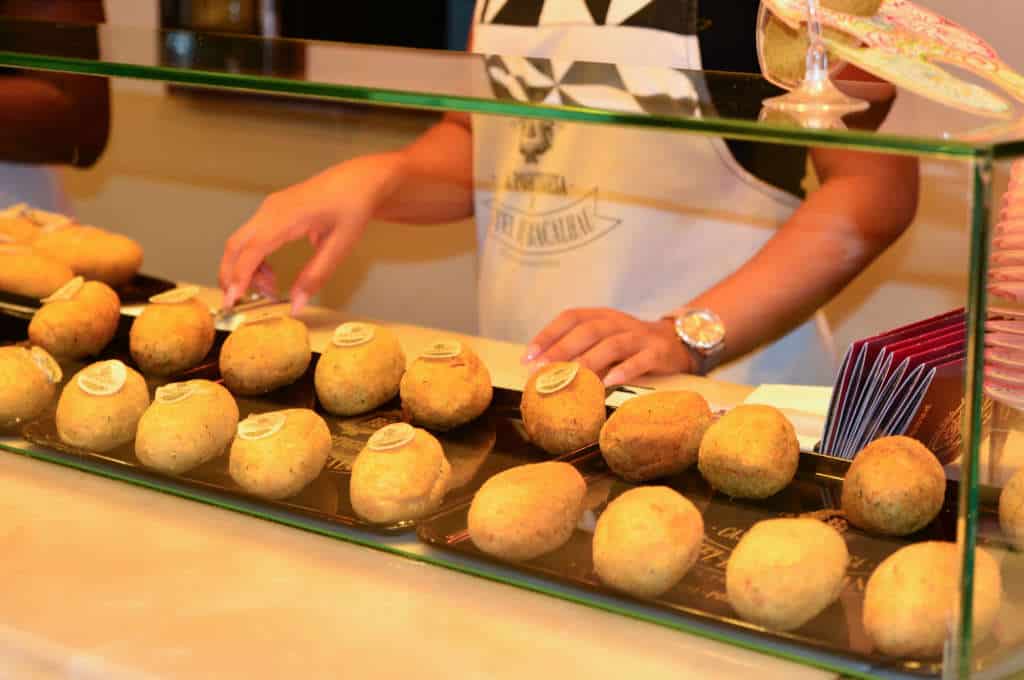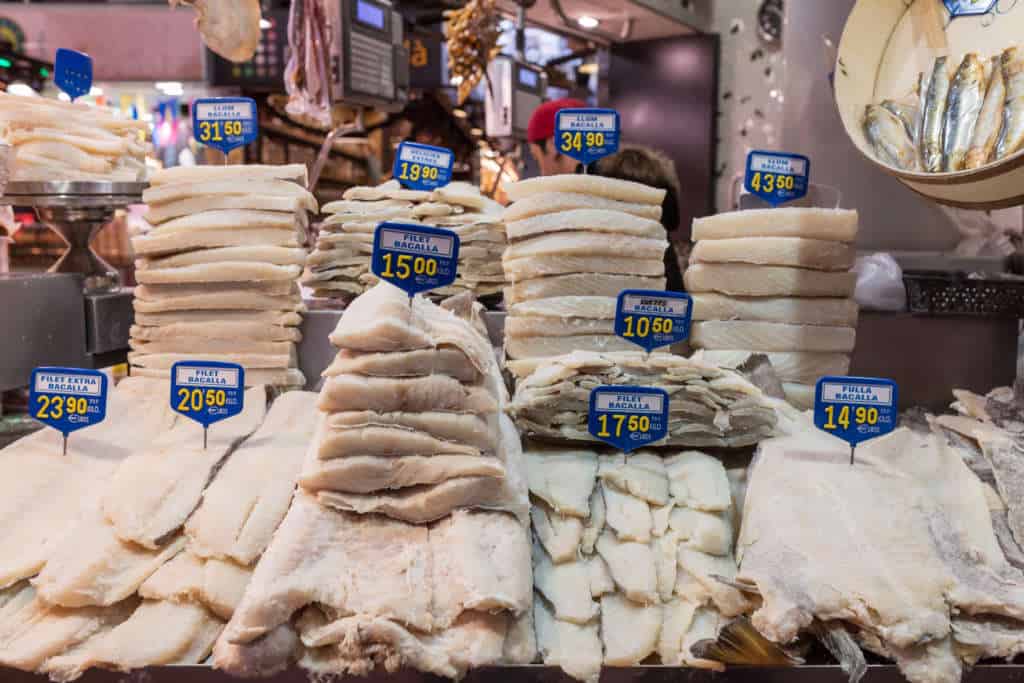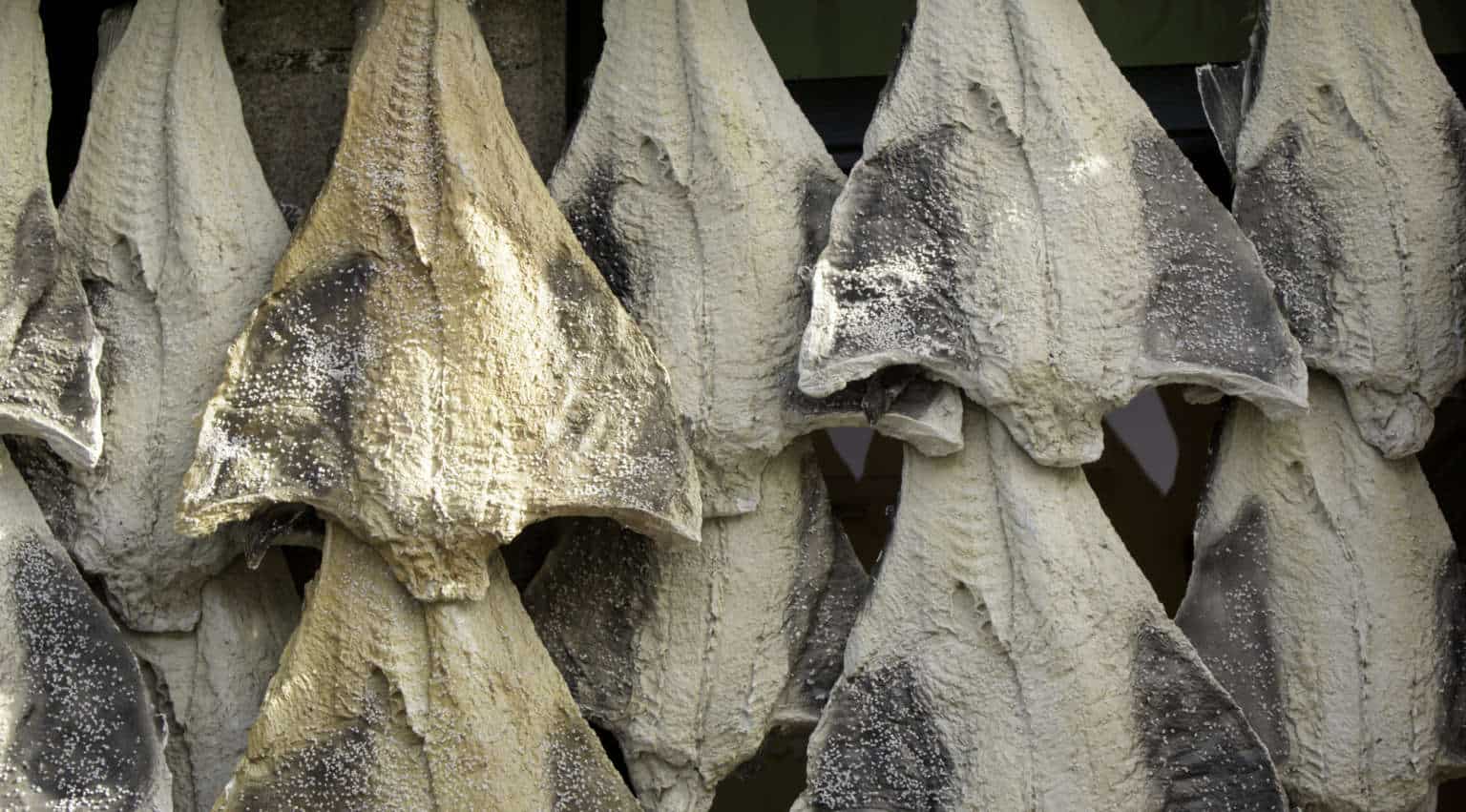Portuguese cuisine, although almost unknown in Europe, abounds in interesting combinations of ingredients, often completely new to our palates. By far the most popular dish of Portuguese cuisine is bacalhau. The salt-cured cod is prepared in thousands of ways and is still eaten every day by several percent of Portuguese.
What is a bacalhau?
Bacalhau is a form of cod preparation that involves salting the fish generously and drying it for many hours. Before preparation, the fish is soaked for several hours to get rid of the salt, and then cooked over a fire, in the oven or boiled.

Hanging bacalhau sheets in front of the Casa Oriental store in Porto
The popularity of the fish and the way it is prepared comes, as with many European dishes, from its extremely low price. The popularity of bacalhau in Portugal was also influenced by its climate, which makes it extremely difficult to store food without a good preservation process. Thanks to the drying process, cod could be caught by fishermen, then stored for months, and only then eaten. Bacalhau gained particular popularity during the period of Portuguese domination of the oceans. Thanks to its qualities, it could be stored for months below deck, and with the discovery of the largest shoal of cod in Newfoundland, it became a staple Portuguese fish.

Before being prepared, bacalhau must spend at least a dozen hours in water to get rid of the salty aftertaste
There is a belief among the Portuguese that bacalhau can be prepared 365 ways, so that each day can be savored in a different way. The most popular way to prepare bacalhau is “à Brás.” First, fry potatoes cut into thin sticks. Before throwing it into the pan, we tear the fish into small pieces – traditionally this is done with our hands. Then we fry it together with onions and garlic, and when it takes color we add to it the previously fried potatoes and eggs, leaving them until they are cooked. Before serving, pour olive oil over the whole thing with chopped parsley and add olives.

Bacalhau a bras served with salad, lemon and olives
Bacalhau is also served on Portuguese Christmas Eve. It is most often found in the form of “de Consoada” served with hard-boiled eggs. Also a Christmas Eve dish are the equally common “Bolinhos de Bacalhau” or “Pastéis de Bacalhau,” which are fried fish balls in batter with various toppings. Remember, if one way of serving bacalhau doesn’t appeal to you – be sure to try another. I especially recommend those fried in the oven – bacalhau assado no forno.

Pastéis de Bacalhau at Casa Portuguesa do Pastel de Bacalhau, Lisbon’s most popular bacalhau croquette cafe. Be warned, they are expensive at this place!
History of bacalhau
The history of bacalhau is inextricably linked to the thalassocracy era in Portugal, however, the process of drying salted meat itself was already known in early historic times and even earlier. Around the eighth century, the Vikings discovered a method that involved hanging fish, drying it and consequently obtaining the so-called stockfish. Two centuries later, cod prepared in this way was an export commodity of the Scandinavian peoples. The following centuries were full of changes on the political map of Europe. Simultaneously to them, the nations controlling the most abundant fishing grounds changed.

Bacalhau can also be found in Spain or Italy (baccala). Pictured here in Barcelona’s La boqueiria market
The early Nordic dominance gave way initially to fishermen from the Bay of Biscay region, followed shortly thereafter by Portuguese, French and English fishermen. Contributing to the booming popularity of bacalhau was the periodic extinction of herring during the Middle Ages. Herring was the most commonly eaten fish by Christians on Friday, a meatless day, until the 12th century. Of course, bacalhau was especially popular among the lower classes. Kings and princes were not befitting to eat simple foods, so salted cod with a small amount of spices in the Middle Ages was mainly eaten by middle-class people. It should be mentioned that the process of drying cod in salt itself was equally popular in Spain, Italy and other Mediterranean countries, but today it is in Portugal that it is most popular.
Despite this, such an important commodity was associated with numerous trade conflicts. The largest cod habitat, most likely located near Newfoundland, was completely taken over by a flotilla of ships from Oporto, which had a map of the coast in 1472. The area, after describing in detail the shoals inhabiting it, was named “Terra dos Bacalhaus.” Documents of this troubled period were written down by the Dominican Bartolome de las Casas. The unfettered market and prosperity ended at the end of the 16th century, when Spain took away the neighboring country’s independence. After independence, the Portuguese power no longer reestablished itself as an unshakable potentate in cod production, but continued to participate in the European economy of this dried specialty, thanks to the salt deposits needed in the production process in the Setúbal and Aveiro area.
Cod did not return to the tables of the bourgeoisie and the mighty until the 20th century. Its price rose, mainly due to the reduction of fishing and increased competition in the market, and it gained further thanks to the return of European cuisine to its roots, where simple, inexpensive and prepared with fresh ingredients began to prevail over complex dishes.
